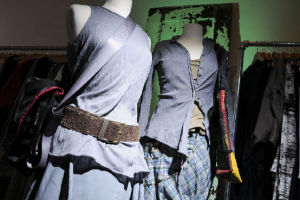Eco-friendly fashion helps environment
Eco-friendly fashion is not new to the American consumer, but it is getting more prominent every year. Stores such as REI, Whole Foods and, more recently, Nau in Bellevue Square have a selection of performance clothing made of environmentally friendly fabrics. Olivine, a trendy boutique in Ballard has an array of sustainable clothing, shoes, accessories and beauty products. Their fashion-forward trendy designs are a far cry from the once traditional shapeless clothes made of hemp.
When it comes to our own hometown, the two Mercer Island women’s clothing stores have a limited selection of clothing made of organic cotton or vegetable-based fabrics. Tatters carries ReSet, a clothing line from Italy made of cotton and vegetable fibers, and Aimee G dresses and skirts made from organic materials. They also sell Alchemy and RetroActif purses and totes made of recyclable material. What to Wear on Mercer Island offers Lauri B organic cotton sweaters, and soon they will have recycled cotton shirts by Three Dots. Don’t forget that anything re-used is good for the environment; therefore, anything for sale at the Mercer Island Thrift Shop would certainly be considered eco-friendly.
Eco-friendly clothing is made from environmentally sensitive fabrics such as hemp, wool, organic cotton and bamboo (a particularly good choice because it can be easily replenished and does not need a lot of water to grow). There is no use of harmful chemicals or bleaches, which create toxins in the ecosystem that are harmful to the environment and to people’s health. The cotton grown is organic (pesticide free) and thus does not harm wildlife, contaminate other products or get into the food we eat. This is no insignificant fact since almost a quarter of all the insecticides used globally are used in the growing of cotton. The last component of an eco-friendly item is that it is made by people earning fair wages in healthy working conditions, as opposed to people in Third World countries working in sweat-shop conditions.
The manufacturing process is one thing to consider along with the harmful impact of our clothing’s care and maintenance. It is better for the environment to use phosphate-free detergents and use more natural remedies to remove stains (such as lemon juice for bleaching, eucalyptus oil to remove grease, or rubbing alcohol to remove grass stains), and limit the amount of dry cleaning required, since the cleaning agents used in this process are toxic and have several harmful side effects.
Now that you know the facts, you may be asking yourself … so what? Will wearing a T-shirt made of organic cotton solve global warming? Will it solve the energy crisis? The answer is yes, but only if we do it together. Think about it. Every little thing we do helps in a small way, and more importantly, every little thing we do will lead to another little thing, and then to another, and yet another. These little things, when done by thousands or even millions of people, have a net positive impact on the larger environmental issues.
I had the pleasure of chatting briefly with Ed Begley Jr. earlier this month at a green design conference in Seattle. Begley is a Hollywood actor turned environmentalist and star of the popular reality TV show, “Living with Ed.” He started on the path to save the environment back in 1970 by doing little things, and now he has become a major environmental activist. His philosophy is to pick the lowest hanging fruit. If you do things that are easily within your reach, eventually you’ll be able to reach higher and higher, and your impact will be that much greater, or “greener.”
Everyone has a personal responsibility to take care of the environment, even if it is one T-shirt at a time. Set a realistic goal for yourself. Buy exercise clothing that is made from organically grown fabric. In this way, you can help improve the environment while improving your body. Or, keep the clothing you have just a little bit longer. It takes 257 gallons of water just to grow the cotton for one shirt. Take a moment the next time when you are in a store to reconsider whether you really need that shirt, and ask yourself whether or not your purchase justifies depleting that much water from the environment. If even a modest fraction of the population starts following these simple rules, imagine the impact we can all make together.
Debbie Schatzman is a Green Living consultant and has an interior design business focused on making environmentally conscious choices for home and business environments. She can be reached at id.debbie@gmail.com.




